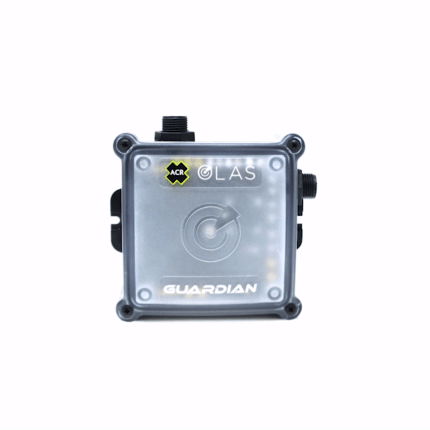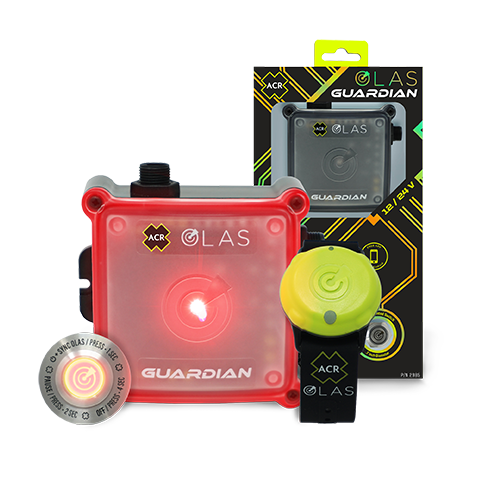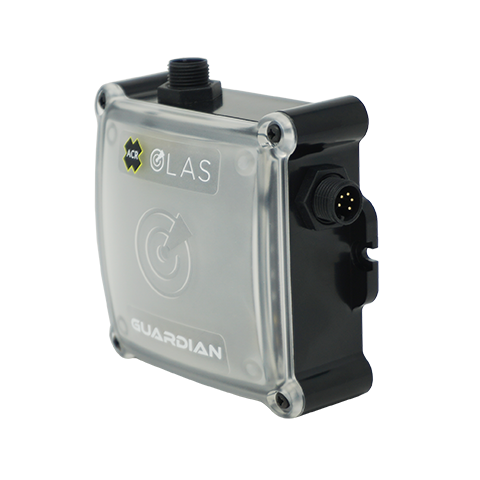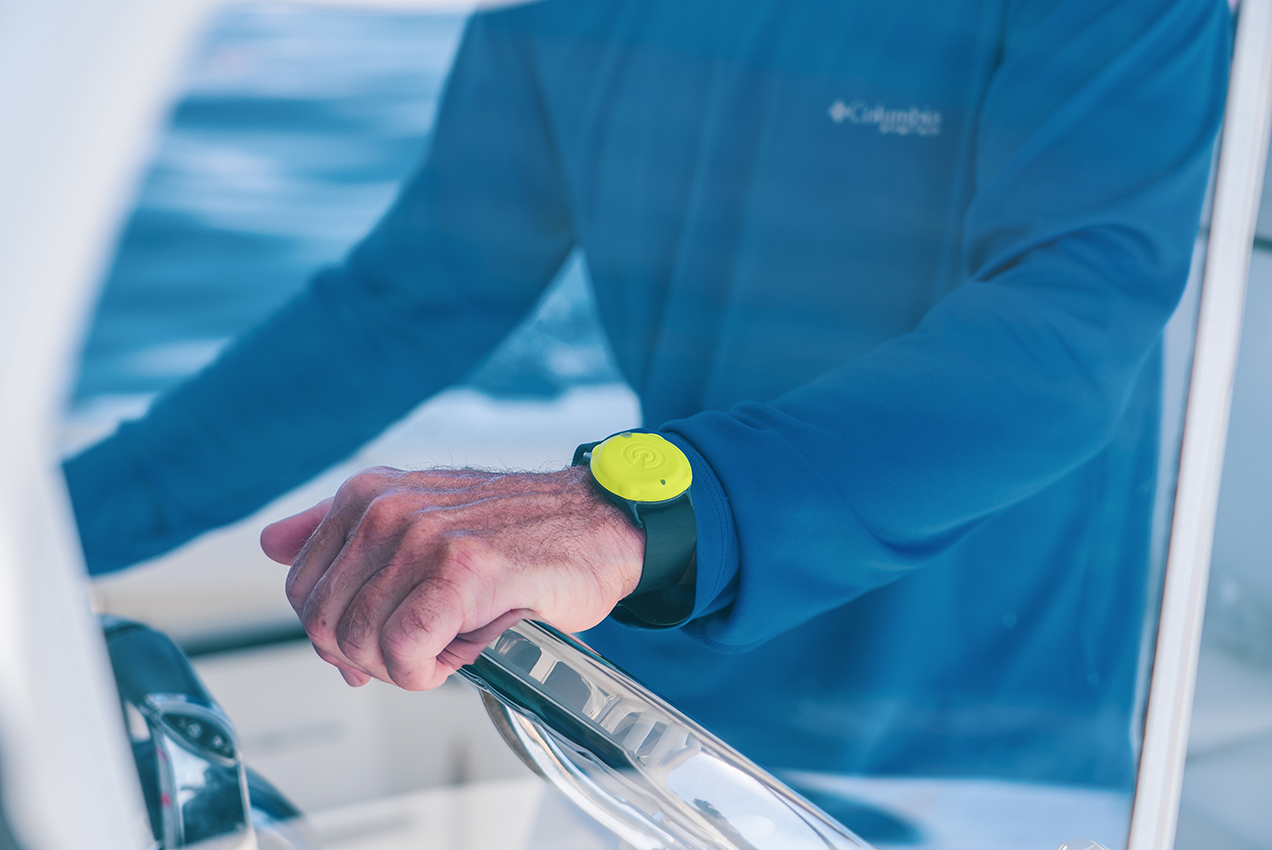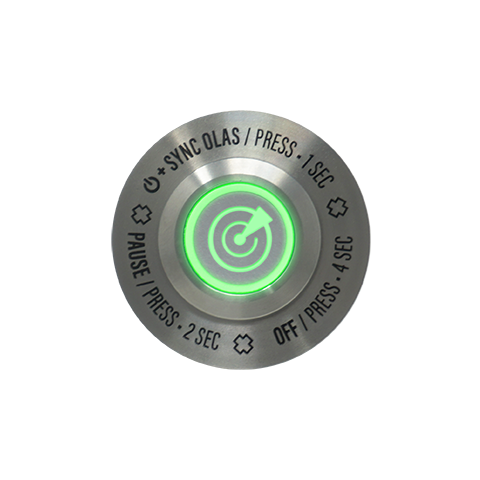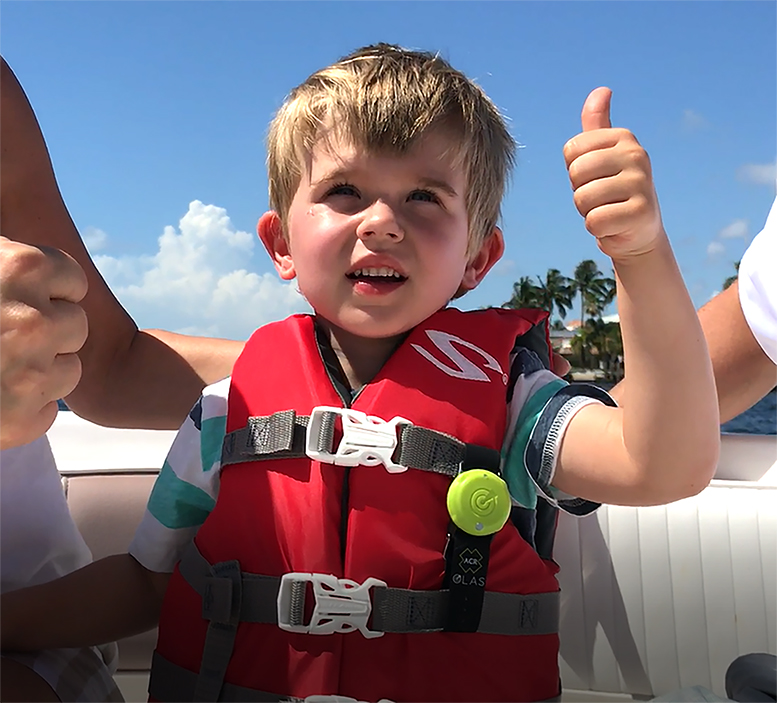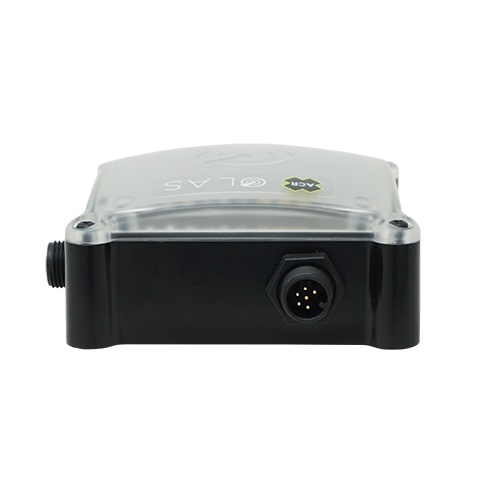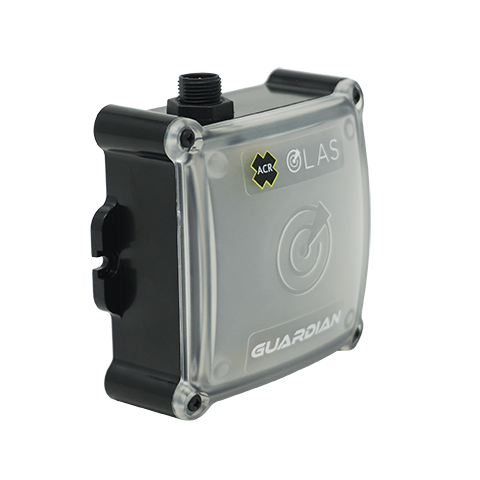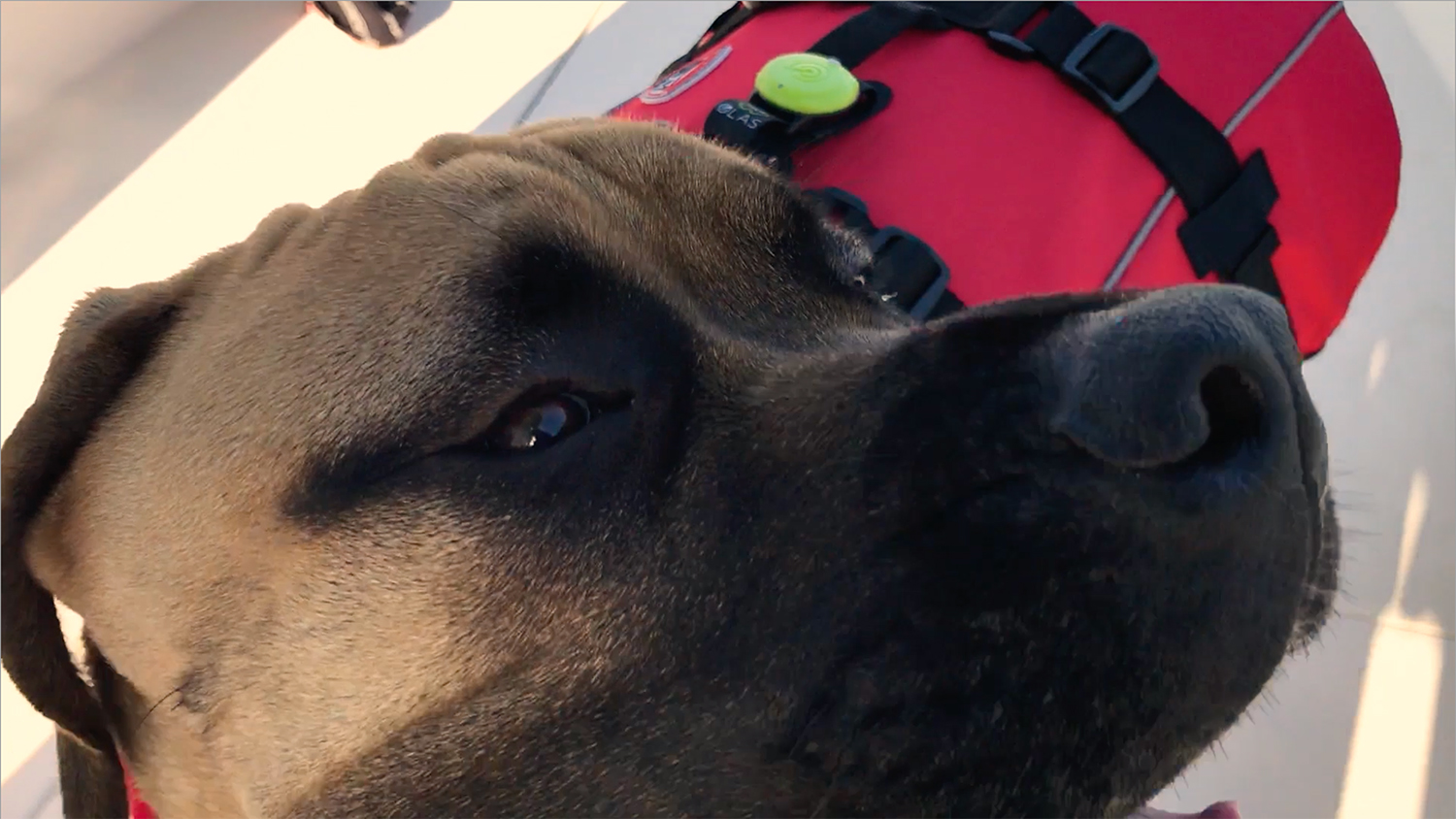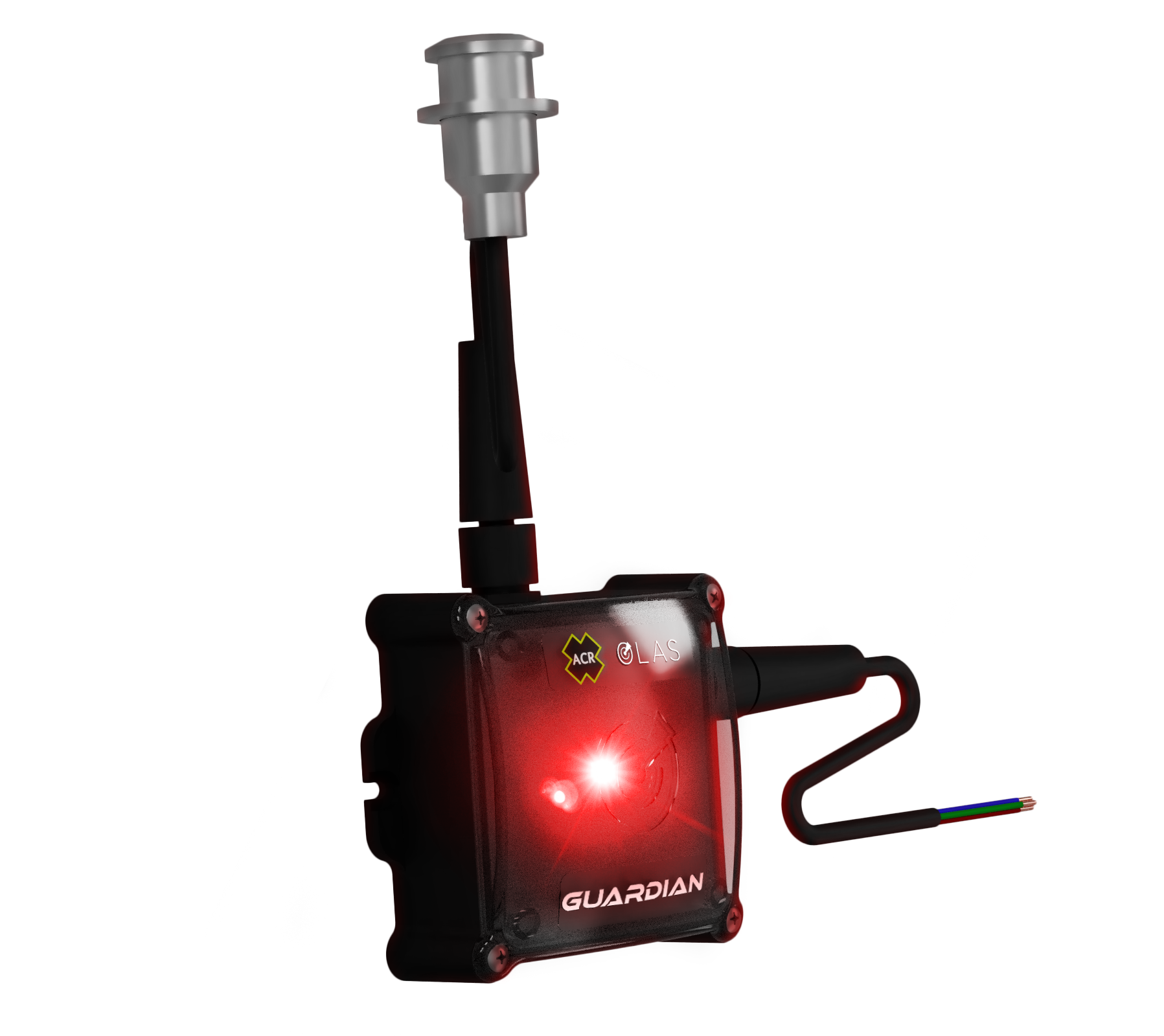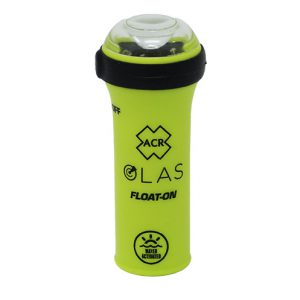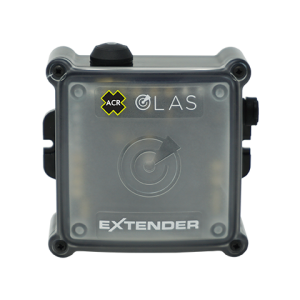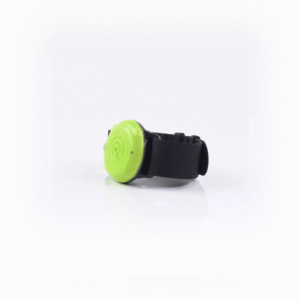How quickly will the engine cut off if I fall into the water with a tag on?
The engine will cut off if the tag is submerged in the water for over 2 seconds.
If I forget my OLAS transmitter or it does not have battery can I still start my engine?
Yes, you do not need to have a tag connected to be able to start the engine. When power is connected to the Guardian it will beep every minute until a tag is either connected or you switch it off by pressing the button for 4 seconds. The engine can be started when the Guardian is switched off, but it will not be acting as a wireless kill switch.
Can I leave the boat without cutting off the engine?
Yes, the Guardian can be put into a Paused state either by by pressing the switch for 2 seconds or via the OLAS app. This will allow any tags to leave the vessel. All tags will need to be back on the vessel before the Guardian can be un-paused.
If I switch off the tag will this set off the alarm and stop the engine?
Yes, switching of the tag is the same as breaking the connection. If the tag is set to stop the engine and alarm both will occur. If it is only set to trigger the alarm, then only the alarm will activate.
The OLAS T2 alert function can be adjusted in the OLAS app so that it can be switched off without triggering the alarm.
What is the maximum distance I can go from the Guardian hub without triggering the engine to cut off?
It is dependent on where the Core or Guardian has been installed and the construction material of the vessel. In normal use you can go up to 50ft from the vessel before the connection is broken. However, if a transmitter is submerged in open water it will disconnect immediately, triggering the alarm or cutting the engine after around 2 seconds.
Can an OLAS transmitter be setup to only alarm without cutting the engine?
Yes, any OLAS transmitter that is being tracked can be adjusted into 3 operating functions.
- (Default) Alarm and cut-off. When disconnected it will trigger the alarm and cut the engine (good for the driver)
- Alarm only. When disconnected it will only trigger the alarm (good for passengers)
- Paused state. When disconnected nothing will happen, allowing the tag to leave the vessel and return later without causing alarm.
The transmitter will remain in this operating function until it is changed using the OLAS app.
How difficult is the Guardian to install?
We recommend using a professional installer who should take between 1-2 hours to install the Guardian. This time will vary depending on your engine setup and system layout.
The power cable is too short for my vessel?
750mm extension power cables are available where longer connections are required.
Can the Guardian be installed whilst keeping the existing kill switch?
Yes, it is recommended to keep your existing kill switch in its location and use the Guardian as an additional safety device. The Guardian can be installed either in parallel or in series to your existing switch dependent on your engine’s configuration.
I do not have a kill switch; can the Guardian still be installed?
Yes, but it is highly recommended that a professional marine electrician is used. Additional purchases may be required from the engine manufacturer.
Where should the Guardian hub be installed?
We recommend installing the Guardian hub within the center console allowing easy access for connecting the wires. It also reduces the need for drilling holes into the center console. We advise the Guardian switch to be in a visible location to ensure all illuminated indications can be seen. If the center console is metal, it may require an Extender, or the Guardian hub will need to be fixed externally.
Do I have to drill a hole to fit the Guardian switch?
Yes, a 21mm hole needs to be drilled where the switch is to be located. Before drilling the hole ensure the switch cable can reach the Guardian hub.
I have a metal boat; will the Guardian still work?
If the center console is metal, it may require an Extender, or the Guardian hub will need to be fixed externally.
I have an outboard engine with a kill switch but no center console, can the Guardian be installed?
If you have a stable 12V power supply generated from your engine or an external 12V battery you should be able to connect the Guardian to your existing kill switch. This is dependent on your engine make, always check with a professional marine electrician.
How should I maintain the Guardian?
The Guardian should be tested regularly to ensure it is working correctly. This can be done by setting the system up as normal and submerging the tag below at least 4 inches of open water. If the OLAS tag has become wet rinse in fresh water and dry. Always store in a cool, dry location. If possible, the Guardian hub should be installed out of direct sunlight. If the Guardian hub is soaked in saltwater, it should be rinsed with fresh water and dried thoroughly. Regularly rinse the Guardian switch with fresh water.
Can the Guardian be installed if I run multiple engines?
Yes, on most boats an existing mechanical kill switch will already be connected to the engines and the Guardian switch wires can be connected as normal to the 2 existing wires leading to the mechanical kill switch. Often a splitter is used to consolidate the multiple engine signal wires into 2 wires. This splitter should not be removed as it may contain diodes. The Guardian should be connected after the splitter has harnessed the multiple engines into the 2 wires. Only connect the Guardian to the 2 wires that connect to the mechanical kill switch. Additionally, please note that the ACR OLAS Multi Engine Connector (P/N 2990) is an available accessory which enables the ACR OLAS Guardian to operate in situations where a multiple engine configuration exists (up to 3 engines in total). Most commonly required on Yamaha twin and triple engine boats, this accessory connects the multiple engines into one kill switch system.
Where more than 2 wires exit the rear of the existing kill switch, primarily on Yamaha multiple engine configurations a multi-pole system and a diode splitter is required to connect the multiple sets of wires into 1 set of wires that can be connected to the Guardian. Contact your engines local representative for further information.
If there is no existing kill switch, we advise that the correct splitters, wires and kill switch setup advised by the engine manufacturer is first setup. Contact your engines local representative for further information.
How should I connect the power and signal wires?
First ensure that the power supply is switched OFF. Then follow the user guide for the correct connection of power and signal wires. All wire connections should use waterproof connectors specifically designed for the marine environment. The Guardian is supplied with marine grade butt splices which will require crimping and heat to ensure a waterproof secure connection, similar marine connectors can also be used. A minimum 20 AWG thickness wire should be used for all connections.
Should I connect the power wires directly to the 12V battery?
The Guardian power wires should always be connected after the batteries isolator switch to ensure it does not continue to draw power when the system is not in use. It is also advised that a 1-3 Amp fuse is input after the battery power switch, before connecting to the positive power wire on the Guardian.
Can the Core or Guardian operate without the mobile app?
Yes, the Core and Guardian can setup, monitor and alert without requiring the OLAS mobile application. Through light indication on the switch and sound signals from the hub, the user can easily check the number of OLAS transmitters being tracked and the state of the device i.e. scanning, tracking, paused or alarming. The OLAS mobile app is only required as an additional tool to aid in setup and monitoring the OLAS system. The OLAS app also acts as an extra alarm and includes rescue screens to aid in MOB rescue including scripted Mayday call and Solo mode, an automated text message for use whilst on your own, within cellular range (minimum 2G or Wi-Fi required).
What is the difference between the Core and the Guardian?
The Core is a portable MOB alarm system which can be plugged into any 5V USB power socket. It has an emergency light and internal alert to indicate a MOB.
The Guardian is a hard-wired solution which can operate from 10-24V. The Guardian can be wired into a vessels existing kill switch, stopping the engine in a MOB situation. The same wiring solution could also be used to activate an external MOB alarm system. The Guardian has an emergency light and internal alert sound to indicate a MOB.
When an OLAS transmitter is switched on, will it automatically be tracked by the OLAS system?
A previously untracked OLAS transmitter needs to be brought within a few meters for it to be tracked automatically.
If an OLAS transmitter has been previously tracked by the Core or Guardian, then it will be automatically tracked when it is within ‘near’ proximity, around 3 meters from the Core or Guardian.
My boat is longer than 50ft, can I still use the Core or Guardian?
Yes, but it is likely you will need to add an OLAS Extender to the system which will allow use on vessels up to 80ft using a single Extender or 100ft with 2 Extenders
What is the maximum distance I can go from the Core or Guardian without triggering the alarm?
The distance can vary depending on where the Core or Guardian is installed and the material of the vessel. If the Core or Guardian is located centrally in a vessel effective coverage of a vessel up to 50ft can be achieved. If a transmitter is submerged in open water it will disconnect immediately even if within the 50ft range.
Can an OLAS transmitter leave the vessel without triggering an alarm?
Yes, but the OLAS system will either need to be in Pause or the individual tag will need to be in a paused state. To pause tracking of individual OLAS transmitters the OLAS app should be used. To pause the whole OLAS system either the OLAS app or the Core / Guardian hub can be used.
When the OLAS system is paused, if an OLAS tag leaves the vessel and does not return can the OLAS system re-start tracking?
It is not possible for OLAS to restart tracking until all OLAS transmitters are back in range. If you try to restart tracking a triple beep indication will occur from the hub. If the OLAS transmitter will not return the OLAS system need to be restarted. Previously tracked tags will be tracked transmitters will be automatically tracked again when they are brought back within 3 meters of the Core or Guardian.
What should I do when an OLAS transmitter has set off the alarm and then been recovered back to the vessel?
Bring the OLAS transmitter back within 1 meter of the Core or Guardian hub. If the Core or Guardian hub is still alarming press the button once to pause the alarm and then press the button again to restart tracking.
After the tag has been brough back within 1 meter tracking will automatically restart after 1 minute if it has not already been restarted.
If the Tag wearer has been retrieved from a MOB situation, is the Tag automatically connected again when they are back aboard?
(Short Answer) Yes – the OLAS transmitter needs to be brought back within 1 meter of the hub, then press the hubs switch once to start the system tracking again or after 1 minute it will start automatically
(Long answer)
- After a MOB alert the user needs to press the hubs switch once to pause the alarm.
- The Guardian is in now in a paused state. This allows the vessel to be operational to perform a rescue.
- Whilst the Guardian is in the paused state it sounds an alert every 6 seconds to clearly indicate it is not tracking.
- The Guardian cannot resume the original tracking until the missing tag is on the vessel
- Once the MOB is back on the vessel, bring it within 2 meters of the hub and press the switch once.
How can I check to see how many OLAS transmitters are being tracked?
Press the switch on the hub once, it will then indicate the number of tracked OLAS transmitters with a sounds and light signal.
Alternatively, the OLAS mobile app will display any OLAS transmitters within range.
The alarm is not triggered when I put the OLAS transmitter into a bucket of water?
The OLAS transmitter needs to be submerged by up to 4 inches in open water. If submerged in a bucket the wireless signal can transmit out of the side and bottom of the bucket.
If I switch the OLAS tag off will this trigger the alarm?
Yes, switching the OLAS tag off is the same as disconnecting the OLAS tag by falling overboard or submerging it in open water. We recommend testing the OLAS system regularly.
The OLAS T2 can be setup to either activate the alarm when switched off or to switch off silently. The alert function can be adjusted in the OLAS mobile app.
What measures can I take to ensure the optimal performance of the OLAS technology when using the mobile app:
- Do not connect other Bluetooth devices whilst using the OLAS app
- Ensure the OLAS app is at least 1 meter from other RF transmitting devices
- Select ALWAYS for location access in your App settings
- Allow notifications
- Only 6 OLAS tags should be ON within range of the OLAS app (if tracking without the Core or Guardian)
- Avoid carbon, metal or water as this will block the OLAS data
- Always check connections before setting off
What is the minimum phone requirement?
iPhone 5 onwards / 3rd generation iPad onwards / Android 4.4+ / Bluetooth LE (The Bluetooth chip in some Android devices can vary, always check compatibility after purchase and return if not suitable).
What is the maximum distance / Yacht size?
Direct tracking with the OLAS app is suitable for vessels up to 30ft.
Tracking via the Core or Guardian is suitable for vessels up to 50ft.
Tracking using additional Extenders is suitable for vessels up to 100ft.
Always test the range limitations to avoid false alerts.
Does the tag transmit GPS?
No, the GPS is taken from your mobile device running the OLAS app. It is recorded at the time of the alarm, like pressing the MOB button on a chart plotter.
Where does the OLAS app direct back to?
The app is always directing back to the last known location of the OLAS tag I.e. the point at which the alert sounded.
What is the battery life?
If turned on and left on up to 4 months. Every time the OLAS tag is switched OFF/ON more power is used. On average around 3 months.
How many phones can use the OLAS app?
Any compatible phone can download the OLAS app.
The OLAS app is free of charge and will be updated regularly as and when technical advances are made.
Is the battery user replaceable?
On the OLAS tag yes, it uses a CR2477. On the OLAS Float-On and OLAS T2 the battery is rechargeable.
How many OLAS transmitters can be attached to 1 phone?
Up to 6 transmitters can be tracked. Ensure no more than 6 are within range of the phone to avoid false alarms.
Can I use a mixture of OLAS tags and OLAS Float-On’s?
Yes, you can use both connected on the same app. They will automatically indicate which is which.
How do you identify different tags?
When first purchased the tag or Float-on will have a number that will also be represented when it is seen in the app, the name of the tag or Float-On can then be changed. The app can also be used to revert back to the original number.
How can I monitor the battery?
The OLAS tag indicates its battery status in the OLAS app. If the app is running when the level gets below 10% is indicated in the OLAS app.
The OLAS Float-On has battery indication using the traffic light system. When a charge is necessary it will illuminate solid red.
What happens if there are more than 6 OLAS transmitters around 1 device?
The 7th OLAS transmitter may push one of the previous 6 from the list causing a false alert. For this reason, only 6 devices can be used within the range of the OLAS app.
What are the optimum OLAS app settings to avoid false alerts?
‘Always’ should be selected in your App settings and notifications should be allowed.
Can I have a different Bluetooth device connected?
No. If using the OLAS app it should not have any connections with external Bluetooth devices.
What is the proper method for testing my OLAS TAG or OLAS FLOAT-ON Transmitter in order to provide the most accurate representation of how the mobile app will communicate with the transmitter in a man overboard (MOB) scenario?
- Only test 1 OLAS TAG at a time
- Testing whilst on a moving vessel gives a more accurate representation of how the system operates. The test can also be carried out on land.
- Ensure the OLAS TAG you are carrying the test out with is either switched off to cause the alert or fully out of range by submerging in at least 6 inches of open water. Leave the TAG submerged for the entirety of the test. If the TAG is removed from the water or switched back on whilst still in range of the mobile device the TAG will reconnect and OLAS will resume normal tracking. Placing the TAG in a sink or glass of water will not work.
- You will see TAGS status change from Green reading “Immediate,” “Near,” or “Far” to Red reading “Paused” to “Unknown”
- After 8 to 12 seconds the alarm will sound
- Accept the alarm and then walk away from the TAG. A searching icon will appear to indicate that you are still within 20 meters of the point of loss and would be within visual contact of the man overboard (MOB)
- Having walked approximately 20 meters from the TAG, the searching icon will change to an arrow pointing back towards the point of loss. Continue walking for a further 20 meters, this will simulate the vessels onward movement prior to stopping and changing direction to perform a search and rescue
- When you reach around 40 meters from the point of loss turn around and follow the arrow
- Once back within 20 meters the searching icon reappears, this would indicate when you should initiate a search protocol based on the wind and tidal conditions
- Once back within the 20 meters either switch the TAG back on or remove it from the open water and it will automatically reconnect, cancelling the alarm (if tracking directly with the OLAS app). If tracking via a core or Guardian the alarm need to be manually paused.
When is it necessary to purchase the Guardian Multi Engine Connector (MEC)?
The MEC may be necessary when a vessel has multiple engines (up to 3). The MEC will be needed if the vessel has 2 kill switches on the dash (the MEC brings the 2 kill switches into 1 pair of wires that can be connected to the Guardian). If the engines on your vessel have already been harnessed into 1 kill switch system (1 kill switch key) on the dash and there are only 2 wires connected to the existing kill switch, then there is no need to use a MEC.
| What is an Engine Cut-off Switch (ECOS)? |
|
An Engine Cut-Off Switch is a safety mechanism used to shut off propulsion machinery when the operator is displaced from the helm. |
|
| What is an Engine Cut-Off Switch Link (ECOSL)? |
|
An ECOSL is the device that connects the operator to the ECOS. The link must be attached to the operator, the operator’s clothing, or operator’s personal floatation device. It is typically a coiled lanyard but may also be an electronic fob. |
|
|
| Who needs to use an Engine Cut-off Switch Link ECOSL? |
|
All operators of recreational boats less than 26’ in length that have an Engine Cut-Off Device installed. |
|
| Why is it important to use an Engine Cut-Off Switch Link? |
|
Boats can make sudden and forceful turns that create enough torque to eject an operator from the helm area or completely out of the boat. If thrown out of the boat, there is always the danger of a spinning propeller, especially since an unmanned boat can often start traveling in circles at the point where the ejection took place. Wearing your Engine Cut-Off Switch Link immediately stops the engine and allows the operator to regain control of the boat. |
|
| What are the benefits of using my Engine Cut-Off Switch and Engine Cut-Off Switch Link? |
|
Engine cut-off switches are an important tool to prevent unnecessary accidents, injuries and deaths caused by a recreational vessel operator being unexpectedly displaced from the helm. This includes situations where the operator is ejected from the vessel, which typically leads to a runaway vessel. In these scenarios anyone in the water is a potential propeller-strike victim, all other vessels on the water face a collision hazard, and maritime law enforcement officers face additional risk in trying to bring the runaway vessel to a stop. |
|
| What boats need to have an Engine Cut-Off Switch installed? |
|
Boats less than 26 feet in length that generate more than 115lbs of static thrust (~ 2-3hp) and were built beginning in January 2020. If the boats’ primary helm is inside an enclosed cabin it is not required to have an Engine Cut-Off Switch. |
|
| I recently bought a 2020 model year boat; am I required to ensure that the Engine Cut-Off Switch and Engine Cut-Off Switch Link work? |
|
Maybe. It depends on when the boat was built. If the boat was built in January 2020 or later, the Engine Cut-Off Switch systems must be maintained in working condition for the life of the boat. Just like navigation lights or exhaust blowers. |
|
| What is a \”covered recreational vessel\”? |
|
The term \”covered recreational vessel\” means a recreational vessel that is (A) less than 26 feet overall in length; and (B) capable of developing 115 pounds or more of static thrust (which equates to about 3 horsepower). |
|
| My boat doesn’t have an Engine Cut-Off Switch, do I need to install one? |
|
No, unless the boat was built on or after 1 JAN 2020. The installation requirement applies to manufacturers, distributors and dealers of “covered recreational vessels” after 1 JAN 2020. For those boats, an Engine Cut-Off Switch must be installed and the owner is required to maintain it. |
|
| How do I tell if my boat was built after 1 January 2020? |
|
The ECOS installation requirement was implemented in the middle of the 2020 model year, so determining the model year is the first step. This is done by checking your boats hull identification number (HIN), which all boats are required to have. The HIN is usually found on the starboard outboard side of the transom but can also be found on the boat’s certificate of number (i.e., registration).
Characters 11 and 12 of the HIN represent the model year. If the model year is 19 or lower, the boat DOES NOT need an ECOS to be installed. If the model year is 21 or later, the boat DOES need an ECOS to be installed. If the model year is 20, then the date of certification needs to be determined.
Characters 9 and 10 represent the date of certification of the boat. Character 9 represents the month, A-L for January-December, respectively. The 10th character represents the year of certification, with the last digit corresponding to the last digit of a specific year (e.g., “0” = 2020). For a model year 2020 boat to be required to have an ECOS installed, it would have an “A0” – “G0” certification date for the 9th and 10th characters of the HIN, and “20” for the 11th and 12th characters of the HIN. Please note that a “0” as the 10th character of the HIN could represent 2010 or any other year ending in a “0” including 2020, which is why the model year represented by the 11th and 12th characters must be considered (e.g., “A010” would represent a boat certified in January 2010, and “E000” would represent a boat certified in May 2000.) |
|
| Are there exemptions to the Engine Cut-Off Switch law? |
|
The laws are only applicable to recreational vessels, so they do not apply to law enforcement vessels or other government-owned vessels. There are two exemptions for recreational vessels. The first is there is no requirement to wear the Engine Cut-Off Switch Link if either the main helm of the covered vessel is installed within an enclosed cabin, or if the vessel does not have an engine cut-off switch and is not required to have one. |
|
| Do I need to keep the Engine Cut-Off Switch Link attached at all times? |
|
No. The Engine Cut-Off Switch Link doesn’t need to be attached when the vessel is idling or performing docking maneuvers. The Engine Cut-Off Switch Link must be attached whenever the boat is operating on plane or greater than displacement speed |
|
| What does “on plane” mean? |
|
For a boat, “on plane” means the boat has reached a speed that moves the boat from a “displacement” mode to a “planning” mode. As more power (and speed) is applied, lift increases, and the boat, in effect, rides over its bow wave, reducing wetted area of the hull and thus reducing drag. At this point, the boat is said to be \”on a plane\” or simply \”planning.\” Sailing vessels are generally not capable of getting “on plane” because of their displacement hull, whereas a ski boat, bass boat or runabout can usually achieve planning with little effort. |
|
| How does the Engine Cut-Off Switch work? |
|
When the operator moves, or is thrown, a certain distance away from the Engine Cut-Off Switch, the link is disengaged from the switch. This causes the engine to shut off. Once the link is reinstalled to the switch, the boat can be restarted. |
|
| To what size boats and horsepower does the new Engine Cut-Off Switch laws apply? |
|
The law applies to all boats less then twenty-six (26) feet in length that generate more than 115lbs of static thrust, which is approximately 3 horsepower. |
|
| My boat has an enclosed wheelhouse, am I required to wear the Engine Cut-Off Switch Link? |
|
No, the law gives an exemption to recreational vessels where the main helm of the covered vessel is installed within an enclosed cabin |
|
| My new 25-foot boat that I purchased in 2020 has an Engine Cut-Off Switch installed by the manufacturer. Do I need to use it? |
|
Yes. Assuming the main helm is not in an enclosed cabin. Because your boat is less than 26-feet and equipped with an engine cut-off switch installed by the manufacturer, you will need to use it while the boat is on plane or above displacement speed. |
|
| My 22-foot boat (1995 model) had an Engine Cut-Off Switch, but it was removed by a prior owner many years ago, leaving a hole at the helm. Do I need to repair it and use it? |
|
No. However, the Coast Guard recommends that your repair the switch and use it when operating on plane or above displacement speed. |
|
| My 18-foot boat (2019 model) has an Engine Cut-Off Switch, but it is broken and does not function. Do I need to use it? |
|
No. However, the Coast Guard recommends that your repair the Engine Cut-Off Switch and use it when operating on plane or above displacement speed. |
|
| My 27-foot boat has a working Engine Cut-Off Switch. Do I need to use it while operating on plane or above displacement speed? |
|
No. The law does not require the use of an Engine Cut-Off Switch for any vessel equal to or greater than 26-feet in length, regardless of when the vessel was manufactured. However, the Coast Guard recommends that your repair the switch and use it when operating on plane or above displacement speed. |
|
| My 26-foot sailboat has a 50-horsepower engine that allows me to travel on plane / above displacement speed. Do I need to use an Engine Cut-Off Switch? |
|
No. Regardless of when it was built, a boat 26-feet in length and greater does not require use of an engine cut-off switch, even if equipped. |
|
| My new 20-foot boat that was purchased in January 2020 doesn’t have an engine cut-off switch. Is it supposed to have an ECOS and do I need to use one? |
|
If you purchased a boat in 2020, there is a good chance that boat was built before the ECOS installation requirement was in place. The ECOS installation requirement was implemented in the middle of the 2020 model year, so determining the model year is the first step in determining whether or not your boat is required to have an ECOS. This is done by checking your boats’ hull identification number (HIN), which all boats are required to have. The HIN is usually found on the starboard outboard side of the transom, but can also be found on the boat’s certificate of number (i.e., registration). Characters 9 and 10 represent the date of certification of the boat. Character 9 represents the month, A-L for January-December, respectively. The 10th character represents the year of certification, with the last digit corresponding to the last digit of a specific year (e.g., “0” = 2020). For a model year 2020 boat to be required to have an ECOS installed, it would have an “A0” – “G0” certification date for the 9th and 10th characters of the HIN, and “20” for the 11th and 12th characters of the HIN. Please note that a “0” as the 10th character of the HIN could represent 2010 or any other year ending in a “0” including 2020, which is why the model year represented by the 11th and 12th characters must be considered (e.g., “A010” would represent a boat certified in January 2010, and “E000” would represent a boat certified in May 2000.) If the boat has an ECOS installed, you have to use it. |
|
| I bought my 22-foot boat many years ago and it did not have an engine cut-off device installed by the manufacturer, so last year I added a new wireless engine cut-off device. Am I required to use it? |
|
Yes. If an engine cut-off switch is present, it must be used. |
